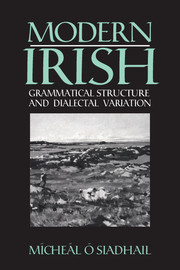0 - General introduction
Published online by Cambridge University Press: 05 June 2012
Summary
Broad aims
This book is an attempt to provide a reasonably comprehensive overview of modern Irish dialects outlining both their shared linguistic structure and their diversity. It is hoped that it may prove useful both to those whose main field of concern is the study of the Irish language and to those whose primary interest is linguistic. In order to ensure a balance between the interests of both students of Irish and those of general linguistics an excess of terminology has been avoided, a number of basic concepts are explained and some background information on the Irish language is provided.
Historical background
Irish, which belongs to the Celtic branch of the Indo-European family, is thought to have been introduced to Ireland by the invading Gaels – about 300 B.C. according to some scholars. Subsequently this Gaelic language extended to Scotland and the Isle of Man. Scottish Gaelic and Manx became distinct from Irish in the seventeenth century and more gradually from each other. Gaelic may be used as a cover-term for all three languages.
The continuum of the written development of Irish is generally divided by scholars into four periods: Old Irish (c. A.D.600-900); Middle Irish (c. 900-1200), Early Modern Irish (c. 1200-1600) and Modern Irish. During the development Irish borrowed vocabulary from languages which impinged on it, including Latin, Norse, Spanish, Anglo-Norman (a dialect of French) and English.
- Type
- Chapter
- Information
- Modern IrishGrammatical Structure and Dialectal Variation, pp. 1 - 12Publisher: Cambridge University PressPrint publication year: 1989



